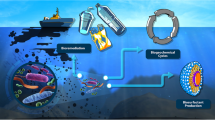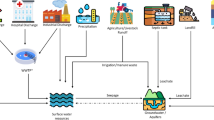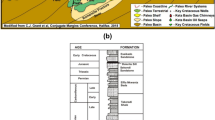Abstract
Bacterial communities inhabiting coastal sediments are subjected to oil spills. In order to examine the early structural response of a complex bacterial community to oil pollution, a kinetic study of the crude oil impact on bacterial communities inhabiting sediments from the contaminated Etang-de-Berre lagoon was performed. The sediments were maintained in slurries in presence or absence of crude oil and the kinetic study was carried out 14 days. During this period, 54% of crude oil was biodegraded showing the importance of the early degradation step. The metabolically active community (16S rRNA transcript analysis) was immediately impacted by the oil input, observed as an apparent decrease of species richness in the first hour of incubation. Nevertheless, this shift was quickly reversed, highlighting a fast, adaptative and efficient response of the metabolically active bacterial population. The high proportion of sequences related to hydrocarbonoclastic strains or petroleum-associated clones in active oiled community was consistent with significant increasing numbers of cultivable hydrocarbonoclastic bacteria at the end of the experiment. We concluded that “Etang-de-Berre” bacterial communities inhabiting oiled sediments for decades adopted a specific structure depending on oil presence and were able to face hydrocarbon contamination quickly and efficiently.





Similar content being viewed by others
References
Altschul SF, Madden TL, Schäffer AA, Zhang J, Zhang Z, Miller W, Lipman DJ (1997) Gapped BLAST and PSI-BLAST: a new generation of protein database search programs. Nucleic Acids Res 25:3389–3402
Bordenave S, Goñi-Urriza MS, Caumette P, Duran R (2007) Effects of heavy fuel oil on the bacterial community structure of a pristine microbial mat. Appl Environ Microbiol 73:6089–6097
Bordenave S, Goñi-Urriza M, Vilette C, Blanchard S, Caumette P, Duran R (2008) Diversity of ring-hydroxylating dioxygenases in pristine and oil contaminated microbial mats at genomic and transcriptomic levels. Environ Microbiol 10:3201–3211
Cappello S, Caruso G, Zampino D, Monticelli LS, Maimone G, Denaro R, Tripodo B, Troussellier M, Yakimov M, Giuliano L (2007) Microbial community dynamics during assays of harbour oil spill bioremediation: a microscale simulation study. J Appl Microbiol 102:184–194
Chauhan A, Fazlurrahman OJG, Jain RK (2008) Bacterial metabolism of polycyclic aromatic hydrocarbons: strategies for bioremediation. Indian Journal of Microbiology 48:95–113
Cole JR, Chai B, Marsh TL, Farris RJ, Wang Q, Kulam SA, Chandra S, McGarrell DM, Schmidt TM, Garrity GM, Tiedje JM (2003) The Ribosomal Database Project (RDP-II): previewing a new autoaligner that allows regular updates and the new prokaryotic taxonomy. Nucleic Acids Res 31:442–443
Delille D, Delille B, Pelletier E (2002) Effectiveness of bioremediation of crude oil contaminated subantartic intertidal sediment: the microbial response. Microb Ecol 44:118–126
Evans FF, Rosado AS, Sebastian GV, Casella R, Machado PLOA, Holmström C, Kjelleberg S, Van Elsas JD, Seldin L (2004) Impact of oil contamination and biostimulation on the diversity of indigenous bacterial communities in soil microcosms. FEMS Microbiol Ecol 49:295–305
Filatov DA (2002) PROSEQ: a software for preparation and evolutionary analysis of DNA sequence data sets. Mol Ecol Notes 2:621–624
Floodgate GD (1972) Biodegradation of hydrocarbons in the sea. In: Mitchell R (ed) Water Pollution Microbiology. Wiley-Interscience, New York, pp 153–171
Good IJ (1953) The population frequencies of species and the estimation of the population parameters. Biometrika 40:237–264
Grötzschel S, Köster J, Abed RMM, De Beer D (2002) Degradation of petroleum model compounds immobilized on clay by a hypersaline microbial mat. Biodegradation 13:273–283
Harayama S, Kishira H, Kasai Y, Shutsubo K (1999) Petroleum biodegradation in marine environments. J Mol Microbiol Biotechnol 1:63–70
Head IM, Jones DM, Röling WF (2006) Marine microorganisms make a meal of oil. Nat Rev Microbiol 4:173–182
Howard PH, Boethling RS, Jarvis WF, Meylan WN, Michalenko EM (1991) In: Printup HT (ed) Handbook of Environmental Degradation Rates. Lewis Publishers, Chelsea, MI
Jacquot F, Le Dréau Y, Doumenq P, Munoz D, Guiliano M, Imbert G, Mille G (1999) The origins of hydrocarbons trapped in the Lake of Berre sediments. Chemosphere 39:1407–1419
Kasai Y, Kishira H, Syutsubo K, Harayama S (2001) Molecular detection of marine bacterial populations on beaches contaminated by the Nakhodka tanker oil-spill accident. Environ Microbiol 3:246–255
Kumar S, Tamura K, Nei M (2004) MEGA3: integrated software for Molecular Evolutionary Genetics Analysis and sequence alignment. Brief Bioinform 5:150–163
Lane DJ (1991) rRNA sequencing. In: Stachenbradt GME (ed) Nucleic acid techniques in bacterial systematic. Wiley, Chichester, pp 115–175
Macnaughton SJ, Stephen JR, Venosa AD, Davis GA, Chang YJ, White DC (1999) Microbial population changes during bioremediation of an experimental oil spill. Appl Environ Microbiol 65:3566–3574
McKew BA, Coulon F, Osborn AM, Timmis KN, McGenity TJ (2007) Determining the identity and roles of oil-metabolizing marine bacteria from the Thames estuary, UK. Environ Microbiol 9:165–176
Nerurkar AS, Hingurao KS, Suthar HG (2009) Bioemulsifiers from marine microorganisms. J Sci Ind Res 68:273–277
Overmann J, Fischer U, Pfennig N (1992) A new purple sulfur bacterium from saline littoral sediments, Thiorhodovibrio winogradskyi gen. nov. and sp. nov. Arch Microbiol 157:329–335
Paissé S, Coulon F, Goñi-Urriza M, Peperzak L, McGenity TJ, Duran R (2008) Structure of bacterial communities along a hydrocarbon contamination gradient in a coastal sediment. FEMS Microbiol Ecol 66:295–305
Prince RC, Elmendorf DL, Lute JR, Hsu CS, Haith CE, Senius JD, Dechert GJ, Douglas GS, Butler EL (1994) 17a(H), 21b(H)-hopane as a conserved internal maker for estimating the biodegradation of crude oil. Environ Sci Technol 28:142–145
Risdon GC, Pollard SJT, Brassington KJ, McEwan JN, Paton GI, Semple KT, Coulon F (2008) Development of an analytical procedure for weathered hydrocarbon contaminated soils within a UK risk-based framework. Anal Chem 80:7090–7096
Röling WFM, Milner MG, Jones DM, Lee K, Daniel F, Swannell RJP, Head IM (2002) Robust hydrocarbon degradation and dynamics of bacterial communities during nutrient-enhanced oil spill bioremediation. Appl Environ Microbiol 68:5537–5548
Singleton DR, Furlong MA, Rathbun SL, Whitman WB (2001) Quantitative comparisons of 16S rRNA gene sequence libraries from environmental samples. Appl Environ Microbiol 67:4374–4376
Thompson JD, Gibson TJ, Plewniak F, Jeanmougin F, Higgins DG (1997) The CLUSTAL X windows interface: flexible strategies for multiple sequence alignment aided by quality analysis tools. Nucleic Acids Res 25:4876–4882
Weisburg WG, Barns SM, Pelletier DA, Lane DJ (1991) 16S ribosomal DNA amplification for phylogenetic study. J Bacteriol 173:697–703
Yakimov MM, Denaro R, Genovese M, Cappello S, D'Auria G, Chernikova TN, Timmis KN, Golyshin PN, Giluliano L (2005) Natural microbial diversity in superficial sediments of Milazzo Harbor (Sicily) and community successions during microcosm enrichment with various hydrocarbons. Environ Microbiol 7:1426–1441
Acknowledgments
This work was funded by the European Community Project FACEiT [STREP- grant N° 018391 (GOCE)]. We would like to thank all partners of the FACEiT project for their useful discussions. We acknowledge the financial support by the Aquitaine Regional Government Council (France), the Ministère de l’Ecologie et du Développement Durable (MEDD - PNETOX project N° CV04000147) and the ANR (DHYVA project, No. 06SEST09). The authors are especially indebted to Dr Anne Fahy for valuable comments on the manuscript and careful reading of the English.
Author information
Authors and Affiliations
Corresponding author
Electronic Supplementary Materials
Below is the link to the electronic supplementary material.
Table S1
Changes in oil hydrocarbons fraction abundance and concentrations (as % of initial values) over 14 days. Each percentage represents the mean of hydrocarbon fractions from replicate samples. (DOC 77 kb)
Rights and permissions
About this article
Cite this article
Païssé, S., Goñi-Urriza, M., Coulon, F. et al. How a Bacterial Community Originating from a Contaminated Coastal Sediment Responds to an Oil Input. Microb Ecol 60, 394–405 (2010). https://doi.org/10.1007/s00248-010-9721-7
Received:
Accepted:
Published:
Issue Date:
DOI: https://doi.org/10.1007/s00248-010-9721-7




